
Dorado is a constellation in the southern sky. It was named in the late 16th century and is now one of the 88 modern constellations. Its name refers to the dolphinfish, which is known as dorado in Spanish, although it has also been depicted as a swordfish. Dorado contains most of the Large Magellanic Cloud, the remainder being in the constellation Mensa. The South Ecliptic pole also lies within this constellation.

A molecular cloud, sometimes called a stellar nursery (if star formation is occurring within), is a type of interstellar cloud, the density and size of which permit being absorption nebulae, the formation of molecules (most commonly molecular hydrogen, H2), and the formation of H II regions. This is in contrast to other areas of the interstellar medium that contain predominantly ionized gas.
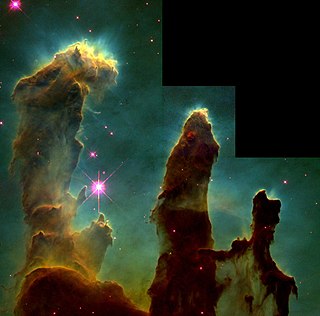
A nebula is a distinct body of interstellar clouds. Originally, the term was used to describe any diffused astronomical object, including galaxies beyond the Milky Way. The Andromeda Galaxy, for instance, was once referred to as the Andromeda Nebula before the true nature of galaxies was confirmed in the early 20th century by Vesto Slipher, Edwin Hubble and others. Edwin Hubble discovered that most nebulae are associated with stars and illuminated by starlight. He also helped categorize nebulae based on the type of light spectra they produced.

Sagittarius is one of the constellations of the zodiac and is located in the Southern celestial hemisphere. It is one of the 48 constellations listed by the 2nd-century astronomer Ptolemy and remains one of the 88 modern constellations. Its name is Latin for "archer", and its symbol is , a stylized arrow. Sagittarius is commonly represented as a centaur pulling back a bow. It lies between Scorpius and Ophiuchus to the west and Capricornus and Microscopium to the east.

Taurus is one of the constellations of the zodiac and is located in the northern celestial hemisphere. Taurus is a large and prominent constellation in the Northern Hemisphere's winter sky. It is one of the oldest constellations, dating back to the Early Bronze Age at least, when it marked the location of the Sun during the spring equinox. Its importance to the agricultural calendar influenced various bull figures in the mythologies of Ancient Sumer, Akkad, Assyria, Babylon, Egypt, Greece, and Rome. The symbol representing Taurus is , which resembles a bull's head.

A dark nebula or absorption nebula is a type of interstellar cloud, particularly molecular clouds, that is so dense that it obscures the visible wavelengths of light from objects behind it, such as background stars and emission or reflection nebulae. The extinction of the light is caused by interstellar dust grains located in the coldest, densest parts of molecular clouds. Clusters and large complexes of dark nebulae are associated with Giant Molecular Clouds. Isolated small dark nebulae are called Bok globules. Like other interstellar dust or material, things it obscures are only visible using radio waves in radio astronomy or infrared in infrared astronomy.

The Orion Nebula is a diffuse nebula situated in the Milky Way, being south of Orion's Belt in the constellation of Orion. It is one of the brightest nebulae and is visible to the naked eye in the night sky. It is 1,344 ± 20 light-years (412.1 ± 6.1 pc) away and is the closest region of massive star formation to Earth. The M42 nebula is estimated to be 24 light-years across. It has a mass of about 2,000 times that of the Sun. Older texts frequently refer to the Orion Nebula as the Great Nebula in Orion or the Great Orion Nebula.

Perseus is a constellation in the northern sky, being named after the Greek mythological hero Perseus. It is one of the 48 ancient constellations listed by the 2nd-century astronomer Ptolemy, and among the 88 modern constellations defined by the International Astronomical Union (IAU). It is located near several other constellations named after ancient Greek legends surrounding Perseus, including Andromeda to the west and Cassiopeia to the north. Perseus is also bordered by Aries and Taurus to the south, Auriga to the east, Camelopardalis to the north, and Triangulum to the west. Some star atlases during the early 19th century also depicted Perseus holding the disembodied head of Medusa, whose asterism was named together as Perseus et Caput Medusae; however, this never came into popular usage.

The Cat's Eye Nebula is a planetary nebula in the northern constellation of Draco, discovered by William Herschel on February 15, 1786. It was the first planetary nebula whose spectrum was investigated by the English amateur astronomer William Huggins, demonstrating that planetary nebulae were gaseous and not stellar in nature. Structurally, the object has had high-resolution images by the Hubble Space Telescope revealing knots, jets, bubbles and complex arcs, being illuminated by the central hot planetary nebula nucleus (PNN). It is a well-studied object that has been observed from radio to X-ray wavelengths.

The North America Nebula is an emission nebula in the constellation Cygnus, close to Deneb. The shape of the nebula resembles that of the continent of North America, complete with a prominent Gulf of Mexico.

Herbig–Haro (HH) objects are bright patches of nebulosity associated with newborn stars. They are formed when narrow jets of partially ionised gas ejected by stars collide with nearby clouds of gas and dust at several hundred kilometres per second. Herbig–Haro objects are commonly found in star-forming regions, and several are often seen around a single star, aligned with its rotational axis. Most of them lie within about one parsec of the source, although some have been observed several parsecs away. HH objects are transient phenomena that last around a few tens of thousands of years. They can change visibly over timescales of a few years as they move rapidly away from their parent star into the gas clouds of interstellar space. Hubble Space Telescope observations have revealed the complex evolution of HH objects over the period of a few years, as parts of the nebula fade while others brighten as they collide with the clumpy material of the interstellar medium.
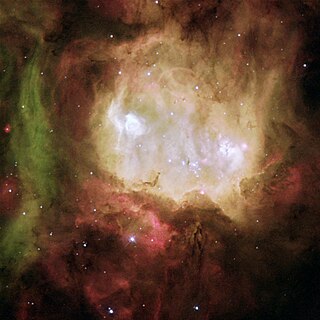
NGC 2080 is a star-forming region and emission nebula to the south of the 30 Doradus (Tarantula) nebula, in the southern constellation Dorado. It belongs to the Large Magellanic Cloud, a satellite galaxy to the Milky Way, which is at a distance of 168,000 light years. NGC 2080 was discovered by John Frederick William Herschel in 1834. The Ghost Head Nebula has a diameter of 50 light-years and is named for the two distinct white patches it possesses, called the "eyes of the ghost". The western patch, called A1, has a bubble in the center which was created by the young, massive star it contains. The eastern patch, called A2, has several young stars in a newly formed cluster, but they are still obscured by their originating dust cloud. Because neither dust cloud has dissipated due to the stellar radiation, astronomers have deduced that both sets of stars formed within the past 10,000 years. These stars together have begun to create a bubble in the nebula with their outpourings of material, called stellar wind.
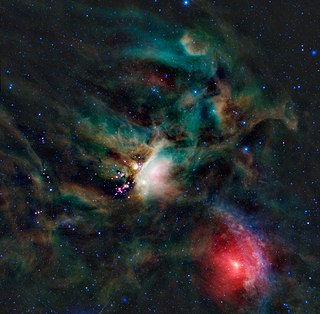
The Gould Belt is a local, partial ring of stars in the Milky Way, about 3000 light years long, tilted toward/away from the galactic plane by about 16 to 20 degrees. It contains many O- and B-type stars, amounting to the nearest star-forming regions of the local spiral arm, to which the Sun belongs. It has been largely superseded in definition by the Radcliffe Wave. The Sun is closest to the Orion (constellation) part of its recent star-created sub-belt of the many times longer Orion Arm. This means the solar system is about 325 light years away, though about 100 light years further to the more extensive Radcliffe Wave's stars, dust and gas in the Taurus Molecular Cloud.
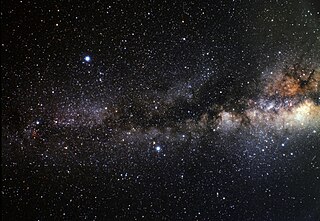
In astronomy, the Great Rift are the nearby dark dust clouds that significantly obscure (extinguish) the center and most radial sectors of the Milky Way galaxy from Earth's perspective.
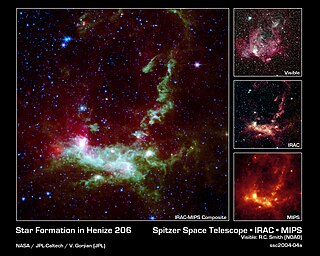
Henize 206 is a nebula in the Large Magellanic Cloud. This luminous cloud of gas and dust houses a cluster of newborn stars. Although Henize 206 was first catalogued in the 1950s, it was reported in NASA press releases in March 2004, for showing several example images generated from the various infrared cameras on the Spitzer Space Telescope launched in August 2003.

RCW 49 is a H II region nebula located 13,700 light years away. It is a dusty stellar nursery that contains more than 2,200 stars and is about 350 light years across.
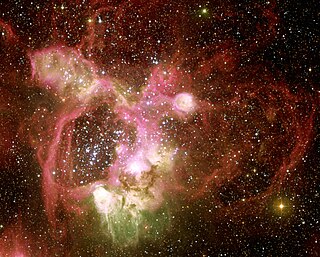
N44 is an emission nebula with superbubble structure located in the Large Magellanic Cloud, a satellite galaxy of the Milky Way in the constellation Dorado. Originally catalogued in Karl Henize's "Catalogue of H-alpha emission stars and nebulae in the Magellanic Clouds" of 1956, it is approximately 1,000 light-years wide and 160,000-170,000 light-years distant. N44 has a smaller bubble structure inside known as N44F. The superbubble structure of N44 itself is shaped by the radiation pressure of a 40-star group located near its center; the stars are blue-white, very luminous, and incredibly powerful. N44F has been shaped in a similar manner; it has a hot, massive central star with an unusually powerful stellar wind that moves at 7 million kilometers per hour. This is because it loses material at 100 million times the rate of the Sun, or approximately 1,000,000,000,000,000 tons per year. However, varying density in the N44 nebula has caused the formation of several dust pillars that may conceal star formation. This variable density is likely caused by previous supernovae in the vicinity of N44; many of the stars that have shaped it will eventually also end as supernovae. The past effects of supernovae are also confirmed by the fact that N44 emits x-rays.

Cygnus-X is a massive star formation region located in the constellation of Cygnus at a distance from the Sun of 1.4 kiloparsecs.

The Radcliffe wave is the nearest coherent gaseous structure in the Milky Way, dotted with a related high concentration of interconnected stellar nurseries. It stretches about 8,800 light years. It runs with the trajectory of the Milky Way arms, and lies at its closest at around 400 light-years and at its farthest about 5000 light-years from the Sun, always within the Local Arm itself, spanning about 40% of its length and on average 20% of its width. Its discovery was announced in January 2020 and its proximity surprised astronomers.


















